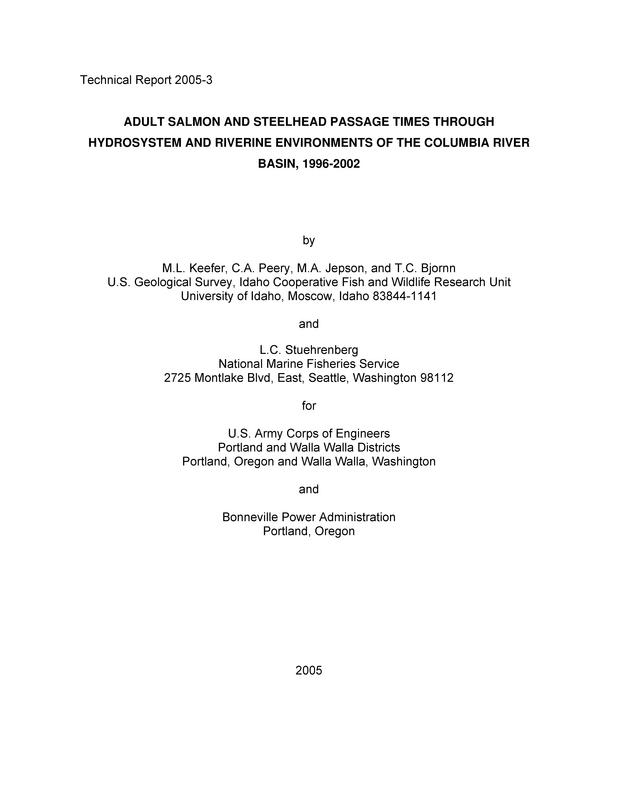PDF
Adult Salmon And Steelhead Passage Times Through Hydrosystem And Riverine Environments Of The Columbia River Basin, 1996-2002 Item Info
- Title:
- Adult Salmon And Steelhead Passage Times Through Hydrosystem And Riverine Environments Of The Columbia River Basin, 1996-2002
- Report Type:
- Technical Report
- Date:
- 2005
- Authors:
- Keefer, M.L.; Peery, C.A.; Jepson, M.A.; Bjornn, T.C.; Stuehrenberg, L.C.
- Affiliations:
- Fish and Wildlife Sciences, University of Idaho; National Marine Fisheries Service, National Oceanic and Atmospheric Administration
- Report Number:
- 2005-3
- Publisher:
- University of Idaho
- Funder:
- U.S. Army Corps of Engineers, Portland District; U.S. Army Corps of Engineers, Walla Walla District; Bonneville Power Administration
- Abstract:
- We assessed upstream migration rates of more than 12,000 radio-tagged adult spring–summer and fall Chinook salmon (Oncorhynchus tshawytscha) and steelhead (O. mykiss) past Columbia and Snake river dams, reservoirs and longer hydrosystem reaches that included multiple dams and reservoirs. Passage rates were also calculated for 1,800 spring–summer Chinook salmon as they passed through 12 unimpounded reaches and tributaries. Most radio-tagged fish from all runs passed mainstem Columbia and Snake River dams in less than two days. Migration behavior in reservoirs and through multiple dam/reservoir reaches varied substantially within and between years and between species. Within years, spring– summer Chinook salmon migrated more rapidly as water temperature and date of migration increased; between years, spring–summer Chinook salmon migrated quickly in low-discharge years and slowly in high-discharge years. Steelhead migrations slowed dramatically when summer water temperatures peaked within each year then increased as rivers cooled in fall. Mean summer temperatures explained more between-year variation in steelhead passage rates than did differences in discharge. Fall Chinook salmon also slowed migration through the mainstem Columbia River during warm water periods. Protracted passage times within the hydrosystem were most likely for fish from all runs that fell back over and reascended dams, and for steelhead that sought thermal refugia by straying temporarily into coldwater tributaries. In tributaries and unimpounded reaches, migration date explained the most variance in spring–summer Chinook salmon migration rates while river discharge, migration year and migration reach were secondary. Both within and between years, spring–summer Chinook salmon migrated more rapidly as migration date increased and more slowly when discharge was high.
- Species:
- Steelhead, Oncorhynchus mykiss Chinook salmon, Oncorhynchus tshawytscha
- Location:
- Bonneville Dam; Columbia River; Snake River; Lower Granite Dam; The Dalles Dam; John Day Dam; McNary Dam; Ice Harbor Dam; Lower Monumental Dam; Little Goose Dam
- Subjects:
- salmonids Federal Columbia River Power System FCPRS radiotelemetry migration passage behavior fishways fallback rates PIT tags passive integrated transponders
- Source:
- University of Idaho, Fish Ecology Research Lab
- Original Filename:
- 2005-03-CK-SH-hydrosystem-passage-1996-2002.pdf
- Format:
- application/pdf
Source
- Preferred Citation:
- "Adult Salmon And Steelhead Passage Times Through Hydrosystem And Riverine Environments Of The Columbia River Basin, 1996-2002", Adult Salmon and Steelhead Migration Studies: 1996-2014, University of Idaho Library Digital Collections, https://www.lib.uidaho.edu/digital/ferl/items/ferl-tr-2005-3.html
Rights
- Rights:
- These files are provided for research purposes with copyright held by the original authors. Please contact the publishing organization for more information about rights.
- Standardized Rights:
- http://rightsstatements.org/vocab/InC-EDU/1.0/

